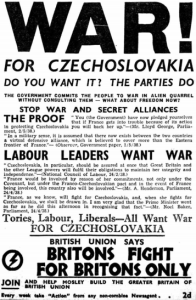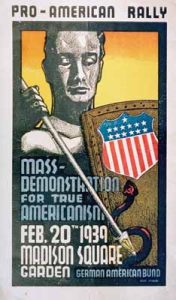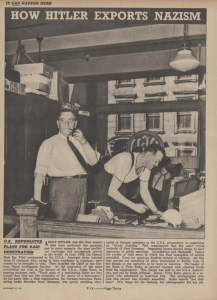27 The Spread of Fascism by Aidan Davies
Fascism in Italy
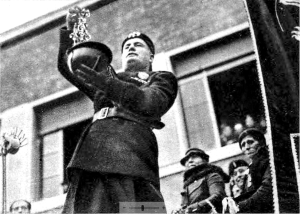
Mussolini receives a donation of “gold for the country” from rural women, 1937 Author Unknown, Wikimedia Commons, Public Domain
| Curriculum Context | VCE Unit 1 Modern History, Ideology and Conflict (VCAA, 2020)
|
| Historical Context | Fascism in Italy and the pacification of Libya 1922 – 1940. |
| Historical thinking concepts | Explore historical perspectives
Construct historical arguments |
| Learning intentions | Students will learn how people both in and out of Italy were affected by Italian fascism.
Students will be able to explain why Italian fascism caused conflict both domestically and internationally and understand why an individual or group of people were disposed to agree/disagree with fascism.
|
Activity
In this activity you will interact with a brief bibliography that provides insight into life as an individual (an imagined historical actor) who was living in or affected by Benito Mussolini’s fascist regime in Italy. You will apply your historical understandings of Italian fascism to construct a possible historical perspective on the National Fascist Party and fascism. Your group will need to justify how this individual’s lived experiences may have shaped their perspectives and beliefs.
Step 1
In small groups you will discuss the possible experiences of one of the following individuals affected by Italian fascism. Applying you knowledge of Italian fascism, you will discuss with your group what their perspective would have been on Benito Mussolini and fascism.
Perspectives
Sayyid Muhammad Idris (Idris of Libya)
Born in Libya in 1889. Idris fought against the Italian Royal Army to defend his country until a peace treaty was signed after World War One. In 1922 Benito Mussolini and the National Fascist Party began a new invasion of Libya which caused Idris to flee into exile in Egypt. Whilst Idris was in Egypt up to 12,000 Libyans were executed and many more interned in concentration camps by Mussolini’s forces. Thousands of Italians colonised Idris’ homeland following out the orders of Mussolini’s fascist regime, attempting a demographic colonisation of Libya.
Luca Angelo
Born in Italy 1920. Raised in a middle-class family. His mother is a teacher, and his father is a builder who fought in World War One. Luca enjoys playing soccer with his friends and attending films. Luca and his father are able to go and watch sport together on a Saturday due to the new 40-hour work week introduced by the government that encouraged ‘Sabato Fascista’ or Fascist Saturday for leisure. Luca has a cousin who is Jewish.
Bianca Changretta
Born in Croatia in 1890 and moved to Rome to work in politics. Bianca works for a socialist newspaper that advocates for an isolationist policy, African independence, and social welfare. Bianca does not wish to have kids and instead likes to write stories and teach in her spare time. Bianca has a long-term boyfriend who is of Ethiopian decent whom she visits on the weekends. Bianca enjoys using her education to spread information on social theories such as socialism, nationalism, communism, and capitalism.
Step 2
In your groups you will present to another group your individual’s perspective on the National Fascist Party. Using your understanding of this time period you will explain your individual’s position by using historical interpretations and historical perspectives. When you have finished presenting the other group will ask questions, respectfully challenging your historical understanding.
Step 3
The exit activity for this lesson involves you considering how you would have interacted with fascism if you were born in Italy in 1900. What would influence how you view fascism and how is this different to the present? What is influencing your thinking?
References
VCAA. (2020). VCE Study Design: History 2022-2026. Victorian Curriculum And Assessment Authority. https://www.vcaa.vic.edu.au/curriculum/vce/vce-study-designs/history/Pages/index.aspx
2. Fascism around the world
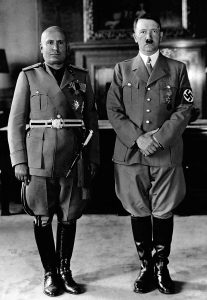
Benito Mussolini and Hitler (19th June 1940, Munich), Unknown Author, Wikimedia, Public Domain
| Curriculum Context | VCE Unit 1 Modern History: Ideology and Conflict (VCAA, 2022) |
| Historical Context | Fascism in England and the USA, 1922 – 1940. |
| Historical thinking concepts | Using sources as evidence.
Establish historical significance. |
| Learning intentions |
Students will learn how fascism as in ideology spread to countries around the globe and why.
Students will be able examine a primary source, explain is historical significance, and use the source to understand it’s time. Students will use their research skills to independently find primary sources and interact with them critically. |
Activity
During this activity you will be using your understanding of fascism to evaluate a set of primary sources. You will choose between Ireland, England, and the USA and complete a source analysis on the provided image. Once you have completed the source analysis you will use your research skills to find a primary source relating to fascism and explain its historical significance.
Source Analysis
Historical questions about sources which may include:
What type of source is this? Who wrote or created it? Why did they write or create it? What was happening at the time the source was created? Who was the intended audience? How does it compare with other sources about the same person or event? How accurate is this source? (VCAA, 2020).
You may use the following structure to present their analysis:
- What can I see?
- What does this present to the audience?
- What does this image reveal about the time it was created?
Sources
| Source 1 – Daily Mail News Article (15th Jan, 1934)
Hurrah for the Blackshirts (Britain, 1934), Daily Mail, Picryl, Public Domain
|
| Source 2 – Benito Mussolini (left) and Oswald Mosley (right)
Oswold Mosley & Benito Mussolini (Italy, 1936), Wikimedia Commons,, Public Domain
|
| Source 3 – British Union of Fascists advertisement in Action Magazine (28th May, 1938)
War for Czechoslovakia (1938, Britain), British Union of Fascists, Wikimedia Commons, Public Domain
|
| Source 4 – Rally Poster for the German American Bund
German American Bund Rally Poster (New York, 1939) Public Domain, German American Bund, Wikimedia Commons,
|
| Source 5 – Australian Journal Article (25th November 1939)
Article on Nazism export (Australia, 1939), Associated Newspapers Limited, Trove, Public Domain
|
References
VCAA. (2020). VCE Study Design: History 2022-2026. Victorian Curriculum And Assessment Authority. https://www.vcaa.vic.edu.au/curriculum/vce/vce-study-designs/history/Pages/index.aspx



